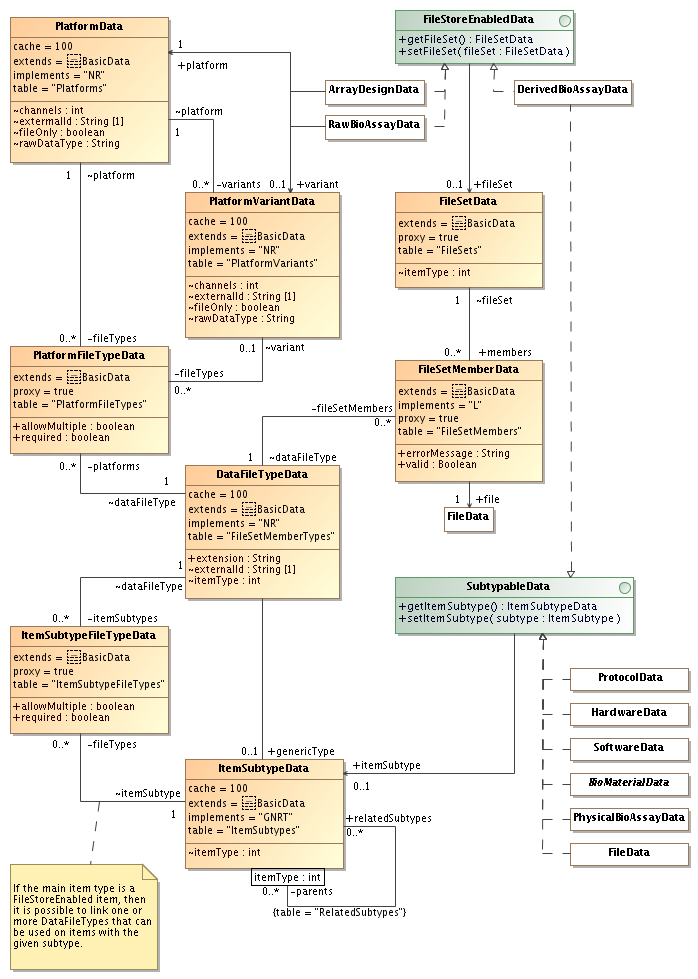This section gives an overview of experimental platforms and how they are used to enable data storage in files instead of in the database. In some senses item subtypes are related to platforms so they are also included here.
See also
The PlatformData holds information about a
platform. A platform can have one or more
holds information about a
platform. A platform can have one or more PlatformVariant :s.
Both the platform and variant are identified by an external ID that
is fixed and can't be changed. Affymetrix
is an example of a platform.
If the
:s.
Both the platform and variant are identified by an external ID that
is fixed and can't be changed. Affymetrix
is an example of a platform.
If the fileOnly flag is set data for the platform
can only be stored in files and not imported into the database. If
the flag is not set data can be imported into the database.
In the latter case, the rawDataType property
can be used to lock the platform
to a specific raw data type. If the value is null
the platform can use any raw data type.
Each platform and it's variant can be connected to one or more
DataFileTypeData items. This item
describes the kind of files that are used to hold data for
the platform and/or variant. The file types are re-usable between
different platforms and variants. Note that a file type may be attached
to either only a platform or to a platform with a variant. File
types attached to platforms are inherited by the variants. The variants
can only define additional file types, not remove or redefine file types
that has been attached to the platform.
items. This item
describes the kind of files that are used to hold data for
the platform and/or variant. The file types are re-usable between
different platforms and variants. Note that a file type may be attached
to either only a platform or to a platform with a variant. File
types attached to platforms are inherited by the variants. The variants
can only define additional file types, not remove or redefine file types
that has been attached to the platform.
The file type is also identified
by a fixed, non-changable external ID. The itemType
property tells us what type of item the file holds data for (ie.
array design or raw bioassay). It also links to a ItemSubtype which is the generic type of data in the file. This allows us to query
the database for, as an example, files with the generic type
which is the generic type of data in the file. This allows us to query
the database for, as an example, files with the generic type
FileType.RAW_DATA. If we are in an Affymetrix
experiment we will get the CEL file, for another platform we will
get another file.
The required flag in PlatformFileTypeData is used to signal that the file is a required file. This is not
enforced by the core. It is intended to be used by client applications
for creating a better GUI and for validation of an experiment.
is used to signal that the file is a required file. This is not
enforced by the core. It is intended to be used by client applications
for creating a better GUI and for validation of an experiment.
The allowMultiple flag in PlatformFileTypeData controls if it should be possible to store more than one file of
the given type in file type. Again, this is not enforced by the core,
but only a recommendation to client applications. The setting is
also used for validation of an experiment.
controls if it should be possible to store more than one file of
the given type in file type. Again, this is not enforced by the core,
but only a recommendation to client applications. The setting is
also used for validation of an experiment.
The ItemSubtypeData class describes a subtype for a main
class describes a subtype for a main itemType. In the simplest
form the subtype is a kind of annotation that is used mainly for creating a
better user experience. If the main item type is also implementing the
FileStoreEnabledData interface, it is possible to
register associations to the file types that can be used together with a given
item subtype. The
interface, it is possible to
register associations to the file types that can be used together with a given
item subtype. The required and allowMultiple
have are used in the same way as in the PlatformFileTypeData
class.
A subtype can be related to other subtypes. This is used to "chain" together
groups of item subtypes. For example, Hybridization
is a subtype for PHYSICALBIOASSAY, which is related to
the Labeled extract (EXTRACT) subtype which is related to
the Label (TAG) subtype. In addition, there are also
several protocol and hardware subetypes mixed into this. The relationship between
subtypes makes it possible for client applications to filter out unrelated stuff,
and to validate experiments.
